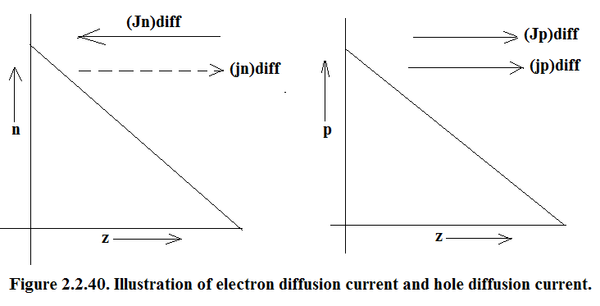| << Chapter < Page | Chapter >> Page > |
2.2.9.Diffusion Process and Diffusion Current.
In kinetic theory of gases we have studied the concept of diffusion. Gas tends to move from higher concentration to lower concentration until gas is uniformly distributed through the room.
Just as potential gradient causes drift current in a similar manner concentration gradient causes a diffusion current. Linear concentration gradient causes a constant diffusion current as shown in Figure 2.2.40.

Conducting electrons and holes always move from high concentration to low concentration hence the rate of carrier movements per unit area or carrier flux density is proportional to the negative of the concentration gradient as given in the equation below:

(2.2.9.1)
Here D n and D p are diffusion coefficient of electron and holes respectively.
The unit of Diffusion Coefficient = cm 2 /s and Einstein Relation gives the inter-relation between Diffusion Coefficient and mobility namely:

Table 2.2.9.1. tabulates the values of diffusion coefficient and mobility foe conducting electrons and holes in intrinsic Si at 300K.
Table 2.2.9.1. Comparative values of diffusion coefficients and mobilities of conducting electrons and holes in intrinsic Si at 300K.
| Material | μ n (cm 2 /V-s) | μ p (cm 2 /V-s) | D n (cm 2 /s) | D p (cm 2 /s) |
|---|---|---|---|---|
| Ge | 3900 | 1900 | 100 | 50 |
| Si | 1350 | 480 | 35 | 12.5 |
| GaAs | 8500 | 400 | 220 | 10 |
When we assign the electronic charge to the flux density we obtain diffusion current density due to conducting electron or due to holes.

2.2.10.Life Time of Minority Carriers.
Life Time of minority carriers is the average survival time of minority carriers before it recombines.
In an ideal semiconductor, there are no impurities, no defects and hence no energy states in the band-gap. Therefore once EHP is thermally generated it has very little likelihood to recombine.
2.2.10.1.Two kinds of recombination.
There are two kinds of recombination: in-direct recombination also known as Shockley-Hall-Reed(SHR) recombination and direct recombination known as Auger recombination.
In ideal semi-conductors, the equilibrium between thermal generation and Auger Recombination of EHP decides the equilibrium value and any perturbation of carrier concentration takes a very long time to come to the thermal equilibrium value. In such circumstances the life-time is very large in minutes and seconds.
In real semi-conductors there are energy states introduced in the energy band-gap. Impurities introduce intermediate energy states in the band gap. Imperfections in the crystal structure or crystal defects also introduce intermediate energy states. These intermediate energy states act as the stepping stone for indirect recombination or for SHR recombination as shown in Figure 2.2.41. But the effectiveness of these intermediate energy states as a recombination center depends on the relative position within the band-gap. The middle position within the band-gap makes the intermediate energy states a very effective stepping stone for in-drect recombination. For instance Au. It introduces intermediate energy states which lie in the middle of the Si band-gap hence it is a very effective stepping stone for recombination.Therefore Au is a life-time killer.

Notification Switch
Would you like to follow the 'Solid state physics and devices-the harbinger of third wave of civilization' conversation and receive update notifications?